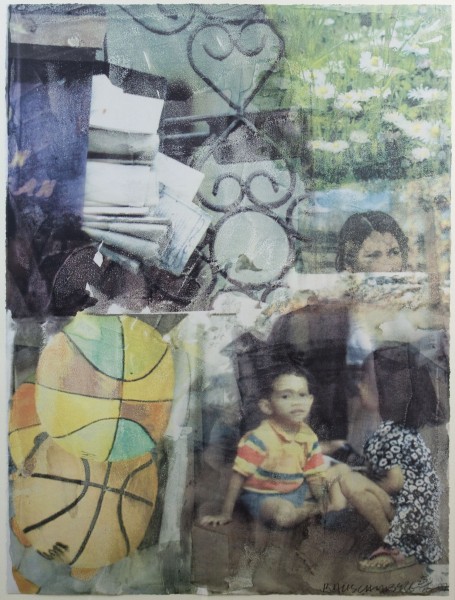Social Justice Collection
Doctors of the World
Robert Rauschenberg
American, 1925–2008
1997
Lithograph
SSWB 2692
Building on the legacy of earlier Dada artists, Robert Rauschenberg obscured the lines between painting and sculpture--really between any media and any other--and even between art and life. As a young man he experienced the post World War II era when productivity and advertising were at new heights. Like everyone at the time, he was bombarded with images from television and magazines. Unlike everyone, he believed that art should incorporate these new, high energy images. In his early career he employed actual artifacts found on the street but in the 1960s he turned to photographs of artifacts and photos of photos, in his two dimensional collaged prints. Rauschenberg was also a collaborator who worked with other visual artists as well as dancers, sometimes performing other times making sets, props, and costumes. Combining such disparate images and activities in his work created something new and unexpected of which he left the interpretation to his viewers. Neo-Dadaist that he was, Rauschenberg allowed chance to determine the placement and combination of found images meaning that there were no predetermined arrangements or established meanings in his work.
In the 1970s and beyond, Rauschenberg embarked on a new endeavor combining art, travel and philanthropy. Like many artists, he hoped art could change society so founded several organizations to that end. With the Rauschenberg Overseas Culture Interchange (R.O.C.I.), he traveled to developing nations and Communist countries, in defiance of Cold War policies. Each trip resulted in an exhibition of Rauschenberg's works inspired by the host country. His commercial success allowed him to support emerging artists in other areas such as Artists Rights Today, an organization that lobbied for artists; Change, Inc., which helped struggling artists pay their medical bills; and Experiments in Art and Technology, a nonprofit foundation to foster joint projects by artists and scientists. He gave millions of dollars to charities for women, children, medical research, other artists and Democratic politicians. In Doctors of the World, created for the international human rights organization of the same name, and L.A Uncovered #8, we see children in conversation among forlorn fragments of neighborhoods such as basketball hoops, signs, rolls of papers, perhaps mail, storefronts, bits of an iron fence. Although no narratives emerge from these found and perhaps randomly placed images, we can imagine that Rauschenberg, the activist and organizer, implies commitment and support for these places.
In the 1970s and beyond, Rauschenberg embarked on a new endeavor combining art, travel and philanthropy. Like many artists, he hoped art could change society so founded several organizations to that end. With the Rauschenberg Overseas Culture Interchange (R.O.C.I.), he traveled to developing nations and Communist countries, in defiance of Cold War policies. Each trip resulted in an exhibition of Rauschenberg's works inspired by the host country. His commercial success allowed him to support emerging artists in other areas such as Artists Rights Today, an organization that lobbied for artists; Change, Inc., which helped struggling artists pay their medical bills; and Experiments in Art and Technology, a nonprofit foundation to foster joint projects by artists and scientists. He gave millions of dollars to charities for women, children, medical research, other artists and Democratic politicians. In Doctors of the World, created for the international human rights organization of the same name, and L.A Uncovered #8, we see children in conversation among forlorn fragments of neighborhoods such as basketball hoops, signs, rolls of papers, perhaps mail, storefronts, bits of an iron fence. Although no narratives emerge from these found and perhaps randomly placed images, we can imagine that Rauschenberg, the activist and organizer, implies commitment and support for these places.


